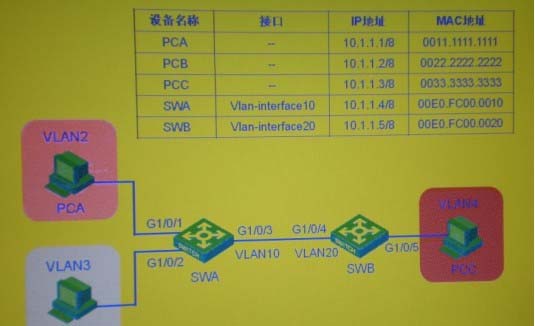- All Exams Instant Download
In the switching network as shown in the figure, VLAN10 is set as Isolate-user-vlan on switch SWA, VLAN2 and VLAN3 are set as Secondary VLAN of VLAN 10; VLAN2-VLAN20 is created on switch SWB, and VLAN20 is set as Isolate-user-vlan , VLAN4 is the Secondary VLAN of VLAN20. After setting the IP address of each device as shown in the figure, the local proxy ARP function is enabled on both SWA and SWB. Initially, the switch and pc did not learn their corresponding ARP entries. In the process of PCA ping PCB, PCA will send an ARP request. After receiving the ARP request message, the PCA will send the destination MAC response. The destination MAC address is
In the switching network as shown in the figure, VLAN10 is set as Isolate-user-vlan on switch SWA, VLAN2 and VLAN3 are set as Secondary VLAN of VLAN 10; VLAN2-VLAN20 is created on switch SWB, and VLAN20 is set as Isolate-user-vlan , VLAN4 is the Secondary VLAN of VLAN20. After setting the IP address of each device as shown in the figure, the local proxy ARP function is enabled on both SWA and SWB. Initially, the switch and pc did not learn their corresponding ARP entries. In the process of PCA ping PCB, PCA will send an ARP request. After receiving the ARP request message, the PCA will send the destination MAC response. The destination MAC address is

A . FFFF.FFFF.FFFF
B . 0011.1111.1111
C . 00E0.FC00.0010
D . 00E0.FC00.0020
Answer: D
Latest GB0-371-ENU Dumps Valid Version with 341 Q&As
Latest And Valid Q&A | Instant Download | Once Fail, Full Refund
Subscribe
Login
0 Comments
Inline Feedbacks
View all comments

